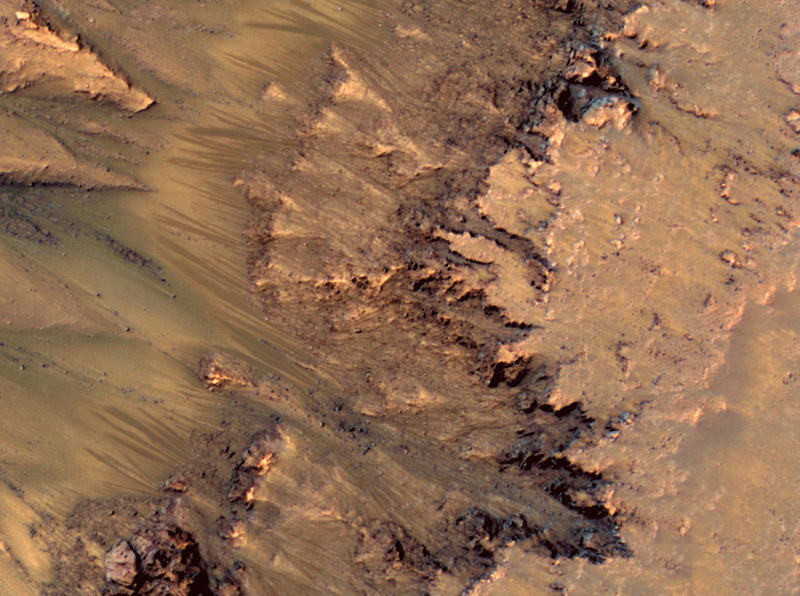The Dry Valleys Helped Scientists Understand a Wet MarsPosted October 8, 2015
The recent announcement of evidence of flowing, liquid water just below the Martian surface made headlines across the globe. When asked what this water might be like, NASA scientist Chris McKay pointed to Antarctica’s briny Don Juan Pond in the McMurdo Dry Valleys. 
Photo Credit: NASA/ EO-1/USGS
Water tracks in Antarctica's Taylor Valley flow into Don Juan Pond, the saltiest lake on Earth.
In fact, researchers supported by the U.S. Antarctic Program, which is managed by the National Science Foundation, have been studying the region for years as a stand in for the red planet, and they helped lay the groundwork for this week’s discovery. “Mars looks more and more like Antarctica every day,” said Joe Levy, a geologist at the University of Texas, Austin. “Both Mars and Antarctica are cold deserts. They experience intense [ultraviolet] radiation, and liquid water is only briefly and ephemerally stable in special locations and at the warmest part of the year.” NASA’s conclusions are based on observations of recurring slope lineae (RSL), long dark streaks that appear and disappear seasonally on the sides of some Martian hills and craters. Scientists have long suspected that these dark lines were likely the result of flowing water, and have studied features found in the Antarctic as a proxy. “The RSL are very similar to water tracks—they’re hundreds of meters long, a few meters wide, appear dark at the surface, and form in spring, advancing downslope, until they disappear in fall,” Levy said. Levy and his team spent years mapping and studying the water tracks in the McMurdo dry valleys. They set up infrared cameras to track the flow of the water, observing how the salty soil pulls water straight out of the air which then collects in the soil and flows downhill. “When [Martian] RSL were first discovered, we helped figure out whether they could plausibly be formed by flowing water,” Levy said. He and his team compared numerous satellite images of the Martian surface with images taken at the Taylor Valley in Antarctica taken over many seasons to see how the features grew and advanced downhill. “We could rule out fast processes like avalanches and slow processes like [soil] creep. We showed that the RSL on Mars flow just like the water tracks on Earth.” 
Photo Credit: NASA/JPL-Caltech/Univ. of Arizona
A false-color satellite photo taken by the Mars Reconnaissance Orbiter, shows similar dark streaks on Mars' Newton Crater.
Levy added also that studying the Antarctic water tracks could help explain the origins of the Martian water. “The wet patches provide one possible answer to the $64,000-question, where is the water in RSL on Mars coming from?” Levy said. “It could be that salts in the soil are pulling water vapor out of the thin Martian atmosphere.” The search for life beyond planet Earth drives much of the effort to study water on Mars. However Levy said that based on observations in Antarctica, it’s unlikely that life would thrive in these RSL. “Water tracks are a hard place to make a living,” Levy said, adding that most multicellular life avoids these tracks because of their high salt concentrations, and their cycle of freezing and thawing every season. “Freezer burn is hard on organisms.” But they’re not completely lifeless. When Levy teamed up with NSF-funded researcher Becky Ball of Arizona State University, they found a small number of microorganisms hanging on in conditions at the edge of what life can survive in. “It turns out that there are microbes living in the water tracks, just far fewer than living outside of them,” Levy said. “These hardy microbes might break down the pickled organic matter in the briny soil, and are some of the best bets for the kinds of organisms and adaptations that microbes would need to survive in Martian RSL.” Buoyed by the recent announcement, Levy is planning to continue his work to understand how these water tracks affect the habitability of the Antarctic soil they’re found in and how they might preserve evidence of past life. “I was amazed that the world was as excited about salty mud on Mars as I am,” Levy said. “Seeing the evidence for water and salts coming together in this paper is very satisfying and also good science.” NSF-funded research in this article: Joseph Levy, University of Texas at Austin, Award No. 1343649 |
"News about the USAP, the Ice, and the People"



For USAP Participants |
For The Public |
For Researchers and EducatorsContact UsU.S. National Science FoundationOffice of Polar Programs Geosciences Directorate 2415 Eisenhower Avenue, Suite W7100 Alexandria, VA 22314 Sign up for the NSF Office of Polar Programs newsletter and events. Feedback Form |


